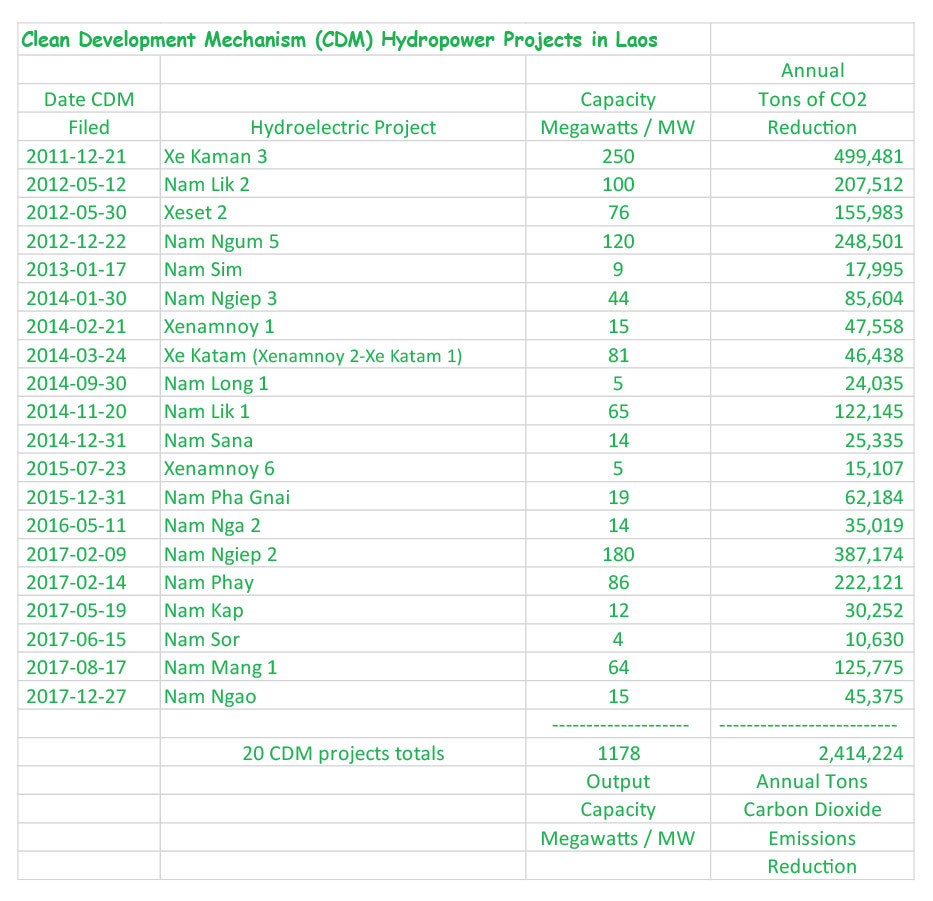
Laos CDM Hydropower Projects info by Hobo Maps - - - HOME - - - Hydropower Projects Summary Page
This web page summarizes hydropower projects in Laos that have qualified as Clean Development Mechanism (CDM) projects under the Kyoto Protocol and are able to receive carbon reduction credits since their operations may result in reduction of overall greenhouse gas emissions.
Hydroelectric power projects in Laos may help reduce greenhouse gas emissions by being clean and having their production reduce the need for polluting plants. What makes CDM projects special is that the carbon credits received makes them financially attractive projects, whereas without the credits the projects would be considered poor investments and may never have been developed.
On Nov. 7, 2020 an article in the Bangkok Post reported that the Thai govt. is planning to retire some old polluting power plants, in part due to clean energy availability coming in from new hydropower plants in Laos that are "in the pipeline". This is specific evidence that the CDM project in general may be having a positive impact. Thai planners are also fortunate to have some power coming in from Laos only when needed during peak periods of demand. Hydropower projects with large reservoirs can efficiently regulate and optmize the timing of power production while most other plants cannot.
We have found 19 hydropower projects in Laos that have been approved as CDM projects by the United Nations entity in charge of administering the system. Most are small-scale hydropower projects that use simplified procedures for submitting applications and annual reports.
The list of projects below is in chronological order by date of filing with the UN agency. Each has its megawatt capacity output listed and estimated tons of annual CO2 emission reductions.
As you can see, 2017 was the last busy year for new applications. The future is uncertain for the Kyoto Protocol system in general as currrent commitments expire at the end of 2020 and progress towards a replacement mechanism has been sidelined by the pandemic.

The Kyoto Protocol (Protocol) was adopted on 11 December 1997 but due to a long ratification process it only entered into force on 16 February 2005. There were 192 Parties to the Protocol.
The Protocol made the UN Framework on Climate Change operational by committing developed countries to limit and reduce greenhouse gas (GHG) emissions in accordance with agreed individual targets. The Protocol recognized that developed countries are largely responsible for the current high levels of GHG emissions in the atmosphere.
During the first commitment period, 37 developed countries and the European Community committed to reduce GHG emissions an average of five percent from 1990 levels. During the second commitment period, parties committed to reduce GHG emissions by at least 18 percent below 1990 levels in the eight-year period from 2013 to 2020 but the composition of parties in the second commitment period was different from the first.
Under the Protocol, countries should meet their reduction targets primarily through national measures. However, the Protocol also offers them an additional means to meet their targets by way of three market-based mechanisms.
1. International Emissions Trading (IET)
2. Clean Development Mechanism (CDM)
3. Joint Implementation (JI)
These mechanisms encourage GHG reduction to start where it is most cost-effective in the developing world since it should not matter where GHG emissions are reduced, as long as they are not released into the atmosphere. The mechanisms have stimulated investment in developing countries by the private sector. The goal is to displace older and dirtier technology with newer and cleaner subsidized infrastructure that will eliminate the need to build additional new polluting systems.
To implement these mechanisms the Protocol established a monitoring, compliance and verification system to ensure transparency and hold Parties to account. The UN Climate Change Secretariat keeps records to verify that transactions are consistent with the rules of the Protocol. The CDM and JI are called "project-based mechanisms," because they focus on new projects. They generate emission reductions called Certified Emission Reductions (CERs). Reductions produced by JI are called Emission Reduction Units (ERUs).
The CDM system rewards new projects in developing countries for each ton of greenhouse gas it is estimated they reduce or avoid. The incentive has led to the registration of more than 8,100 projects in 111 countries and more than 2 billion CERs credits have been issued. In China and Laos many smaller hydropower dam projects have only been constructed because of these credits which acts like a subsidy. These projects were considered financially unattractive without the credits and the subsidy allows their output to go into the grid and hopefully eliminate the need for any future dirty production projects such as new coal-fired plants.
Developed countries and companies that buy the CERs in effect finance the subsidy. They can claim to be green and meeting their GHG reduction commitments while in some cases not changing their polluting operations at all. The CDM program was intended to be global in operation but the activity has mostly been centered on the European Union countries as purchasers of credits which are mostly created by new projects in Asia and India.